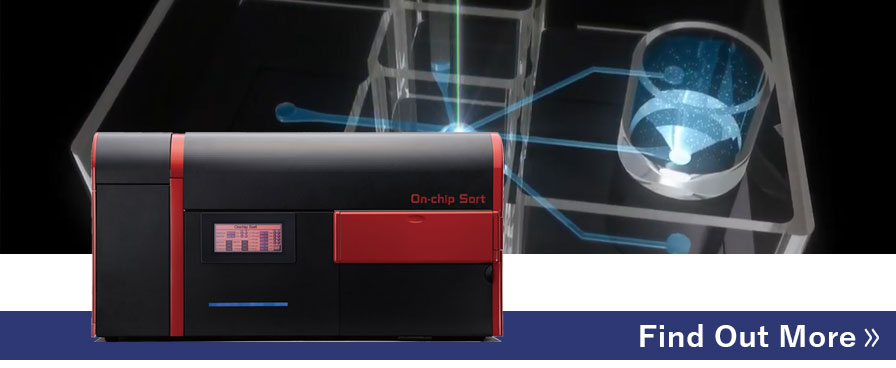With cell purification the starting point of much of biology and medicine, cell sorting has become a critical enabling technology. Most cell sorting systems use flow cytometry, fluorescence detection, and an electrostatic droplet sorting mechanism, a configuration known as fluorescence-activated cell sorting (FACS). These systems sort millions of cells per hour and quantify, at high sensitivity, multiple fluorescent markers simultaneously.[1]
Cell Damage
The shear forces, pressure drops, and clogged nozzles that cells encounter inside conventional electrostatic-droplet cell sorters damage cells, alter their morphology and growth curves, decrease viability, and may even affect cellular genetics. For example, HeLa cells experience a shallower growth curve than normal after cell sorting.
These collective forces are called “sorter-induced cellular stress (SICS)”.[2] SICS is particularly troublesome for delicate cells such as transfected cells, cardiomyocytes, hepatocytes, sperm cells, adipocytes, and induced pluripotent stem cells (iPSCs) and their products.
Even cells that appear normal after purification may have undergone subtle metabolic changes that do not become obvious until the cells are used in an assay or for production. A 2019 study showed that, compared with macrophages purified by centrifugation, cells that have undergone sorting show an altered plasma membrane metabolome resulting from activation of a pro-inflammatory "mechanosensory signaling cascade," and alterations in energy consumption. The authors cautioned that FACS-induced changes "should be taken into account in the design of robust metabolic assays of cells separated by flow cytometry.[3]
A New Sorting Paradigm
The On-chip Sort microfluidic cell sorter, from Tokyo-based On-chip Biotechnologies, improves the prospects for isolating delicate cells unharmed and intact, through proprietary "flow shift" microfluidic technology. This novel approach minimizes shear stresses, pressure changes, collisions, or other cell-altering events. On-chip Sort fits inside a biosafety cabinet so samples and entire workflows can be handled under sterile conditions. Aerosols—a source of environmental contamination—are also avoided due to the nature of the flow shift method.[4]
Because On-chip Sort uses a fully disposable fluid path it also eliminates cross-contamination, a significant source of error and non-reproducibility in the life sciences costing granting agencies an estimated $28 billion per year in the U.S. alone.[5]
On-chip Sort in Action
Autologous chimeric antigen receptor T cell (CAR-T) therapies require isolating patients' rare T-cell phenotypes at 90% homogeneity. Desired phenotypes may carry just a few identifying surface markers, so they are not easily found and isolated. The process, from cell isolation to re-infusion into patients, depends on having a reliable supply of healthy, viable cells. Damaged cells lower the effective harvest and reduce growth curves for expanded cells. One further point: Protocols call for effective removal of potentially teratogenic undifferentiated cells. The need for efficient separation of iPSCs from their differentiated products is therefore great, but conventional cell sorting falls short.
On-chip Sort efficiently removes undifferentiated cells through "multi-step negative sorting" (MSNS) technology.[6]
MSNS works by sorting undesired (in this case undifferentiated) cells to the waste reservoir and channeling the desired (differentiated) cells to a collection reservoir. Differentiated cells are recovered and cycled through again, until a desired level of depletion is achieved. A Japanese research group found that three passes often suffices for complete removal of iPSCs from daughter neurons.
Made from inexpensive materials through injection molding technology, On-chip Sort has been validated in numerous studies using up to six fluorescence channels. Most recently, Japanese researchers used this method to select sperm with a high likelihood of success in in vitro fertilization.
Conclusion
Clinicians increasingly turn to cell sorting to support cutting-edge treatments and diagnostics such as cell-based therapies, liquid biopsy, and high-throughput phenotypic screening. For many applications, particularly where cell recovery is critical, sorter-induced cell damage limits what may be achieved through conventional cell sorting. Single-use microfluidic cell sorting offers a robust, highly accurate alternative, through protocols inducing the lowest possible damage to cells and zero chance of cross-contamination.
The cell sorter using a disposable microfluidic chip
Designed to BioPharma and FACS Core Facilities

About PHCbi
The “bi” part of our new brand PHCbi is not only a shortened form of the word “biomedical” but also represents both our strength and philosophy as an abbreviation of “biomedical innovation.”
Since the launch of our first Pharmaceutical Refrigerator model in 1966, we have taken advantage of this technology to create exceptional medical and laboratory products and services with a high degree of quality and reliability. We have worked to meet the expectations of customers in the medical and life science fields under both the Sanyo and Panasonic brands. See more detail from "About PHCbi". Find PHCbi's customer case study in the world.